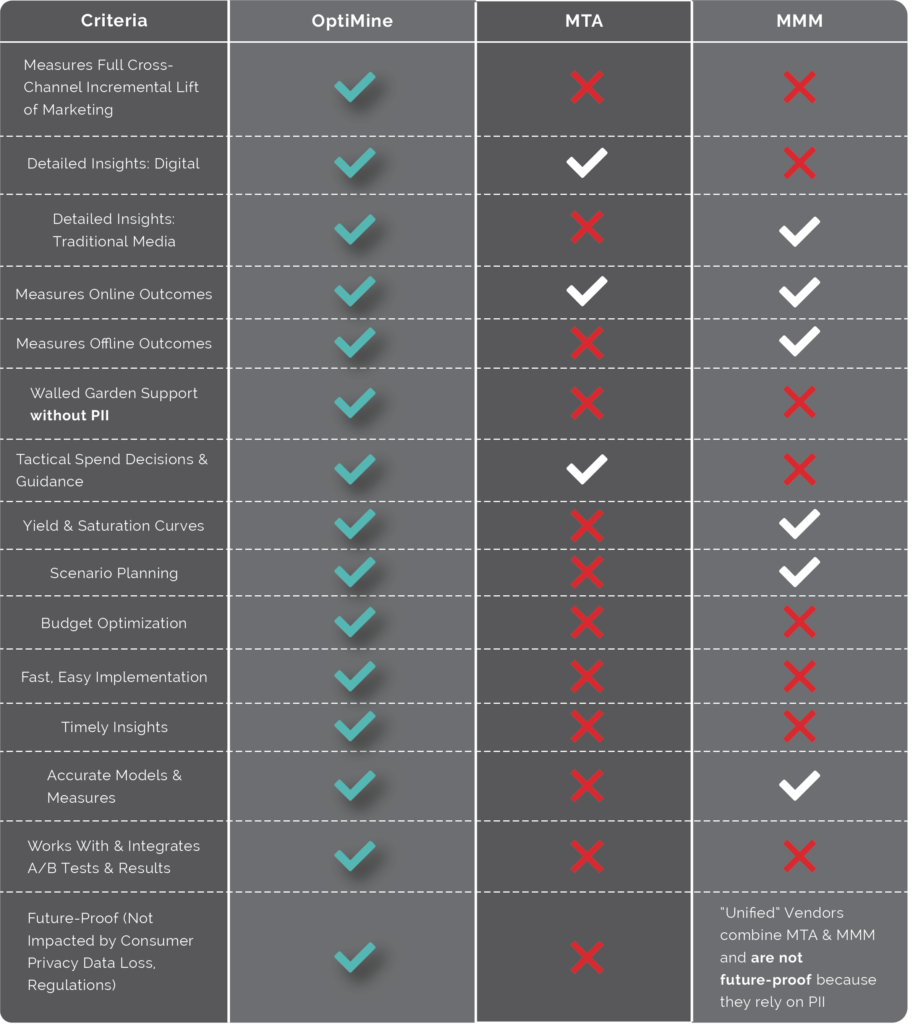Contents
What is Marketing Mix Modeling (MMM)?
12/07/2021

What is Marketing Mix Modeling (MMM)?
Marketing Mix Modeling, also known as Media Mix Modeling- or MMM for short- is a statistical method for building predictive models using multi-variate regression. The models evaluate media impressions and spend, non-marketing factors such as economic conditions or other elements that move business performance more broadly, and converting activity over time to measure the contributions of each of these elements towards conversions (sales, traffic, customer acquisitions, engagement, branding impacts, etc.). These measures then allow the marketer to understand potential outcomes by evaluating different marketing investment levels or other scenarios.
Marketing Mix Modeling has been used by large brands for many decades and was a primary means to understand how large traditional media campaigns (TV, Print, Radio) impact sales activity. MMM can be highly accurate and is a well-proven approach to marketing measurement.
How Does Marketing Mix Modeling (MMM) Work?
MMM uses a time series modeling approach to examine whether changes in media reach (impressions, GRPs, etc.) over time correlate with conversion changes. For a simple example, consider the case where a brand places a billboard next to the highway. The model can now examine sales before the billboard and now whether sales have increased with the placement of the new billboard. If the brand takes the billboard down and sales drop accordingly, puts the billboard back up and sales increase again, the brand can be reasonably confident that the billboard is impacting sales positively. Well designed Marketing Mix Models also account for other factors besides media. In this case, the brand may also try to account for other factors such as the weather, promotions, seasonality, holidays and day-of-week effects before confidently concluding that the media (the billboard) is the reason for changes in sales versus these other factors that may be playing a part in sales changes over time.
While this method is probabilistic in nature, and does not attempt to match media consumption at individual customer levels using PII, it can provide a very accurate measure of the incremental contribution of marketing investments on many different types of outcomes. Also, Marketing Mix Modeling has a major advantage over other measurement approaches such as Multi-Touch Attribution in that it can measure both digital and traditional media as well as online and offline conversion outcomes.
Advantages and Benefits of Marketing Mix Modeling

As mentioned, MMM has several advantages and benefits to the marketing organization:
- Accuracy
- Complete coverage of digital and traditional marketing channels
- Complete measurement of online and offline conversion outcomes
- The ability to estimate and measure media saturation and yield levels, which allows marketers the ability to pinpoint optimal investment levels
- Advanced MMM approaches also provide scenario planning and budget optimization capabilities to allow marketers to run simulations to forecast different outcomes
- MMM uses no PII
What is Scenario Planning?
Strong MMM solutions provide scenario planning tools to allow the marketer to understand potential outcomes and run different scenarios to estimate the potential impacts on conversions. MMM models can also include cost and yield or saturation levels to guide the marketer to the optimal levels of investments by examining the cost-benefit of different marketing channel investment ratios.
What is Budget and Media Plan Optimization?
Some MMM solutions also provide budget and media plan optimization capabilities. These optimization tools examine different investment levels across the entire marketing budget to guide to the most optimal allocation to achieve a goal or outcome. For example, a brand may use budget optimization to help plan their annual marketing budget. They may run optimizations at different budget levels (example: what would happen if we increased our marketing budget by 10% overall?) to zero in on the most effect budget. These optimization tools are beneficial because they allow marketers to make better financial decisions, or make a case to their finance teams for specific investment approaches that will benefit the overall business.
Disadvantages and Shortcomings of Marketing Mix Modeling

Even given the many advantages of MMM, traditional Marketing Mix Modeling solutions have some significant drawbacks and considerations for brands. Most of these weaknesses are a result of the fact that the MMM models are produced and delivered by manual methods requiring expensive, deeply experienced (and expensive) consultants:
- Expensive: there is a reason that only the largest brands in the world have used MMM- they can afford to cover these significant expenses as part of their large marketing and analytics budgets.
- Slow: because traditional MMM is a manual consulting exercise, building models or changing them over time takes a significant amount of time. It is common for brands using MMM to get the measures many months after the period being measured.
- Inflexible: new data, business questions, KPIs and outcomes are all part of the real-world facing marketers and brands. And all of these present challenges to traditional Media Mix Models because they all represent more manual changes, tasks, time and new costs. As a result, many MMM deployments are highly static and don’t change much because brands don’t have the resources to evolve the models over time.
- Not Actionable: nearly all Marketing Mix Models use highly summarized data typically rolled up by week or by month. And because the models are built using highly manual efforts, it is nearly impossible to get deeply detailed guidance from MMM measures. As such, teams get very high-level recommendations that are frequently difficult to execute at any level of precision. This is an even bigger issue within digital marketing channels that frequently have hundreds or thousands of different campaigns, targeting elements and execution approaches, all with very different performance characteristics. These important nuances are missed completely with traditional MMM models.
Summarizing MMM
Media Mix Modeling (MMM) Summary:
| Pros | Cons | Future-Proof Prognosis |
|
Marketing Mix Modeling (also known as Media Mix Modeling or MMM) is:
|
Poor
|
When to Use Marketing Mix Modeling
Marketing Mix Modeling is best used when a brand wants to understand and measure the incremental contributions of their marketing, and in particular, when the brand has a mix of digital and traditional marketing channels. With a more complex media mix, MMM is an ideal fit and can handle this kind of marketing complexity, and most importantly can help the brand get more performance and efficiency from their marketing budget. And with advances in AI and high-speed computing, MMM is no longer a tool just for larger global enterprises but is now an option for all brands that need advanced marketing measurement and optimization.
How to Future-Proof Marketing Measurement?
Over the last 5-7 years, brands hopped on the marketing attribution bandwagon to measure digital advertising, only to be burned by poor models & measures, hidden costs, and inflexible solutions that don’t meet the needs of a modern business. Now with consumer data privacy changes hitting the market and significantly limiting the data available for Multi-Touch Attribution, brands are evaluating other options including MMM.
The great news is that Marketing Mix Modeling doesn’t use PII and as a result, can represent a future-proof measurement option for brands. But traditional MMM solutions and vendors can be a risk due to:
- Expensive solutions
- Slow deployments and model updates
- Guidance lacking in detail
- Inflexible solutions that are difficult to change over time
So to be fully future-proof, brands need to consider solutions and vendors that offer modern, agile solutions built for speed, scale, flexibility and precision.
Read OptiMine’s guide for Future-Proofing Marketing Measurement to learn more about how to plan for your marketing measurement future success.
Comparing OptiMine with MTA and Traditional MMM

More Resources:
- “Your Marketing Measurement is Going Dark” Blog Post
- “Myths of Multi-Touch Attribution” Blog Post
- “Major Consumer Privacy Changes from Apple and Google are Reshaping the Marketing & Measurement Landscapes” Blog Post
- OptiMine On-Demand Webinar: “Apple’s ATT Changes Are Now Live. Learn How It’s Impacting Brands’ Measurement, Performance, & How to Move Forward”
-
OptiMine x TickPick On-Demand Presentation: “ARF Measurement Challenges Showcase”


